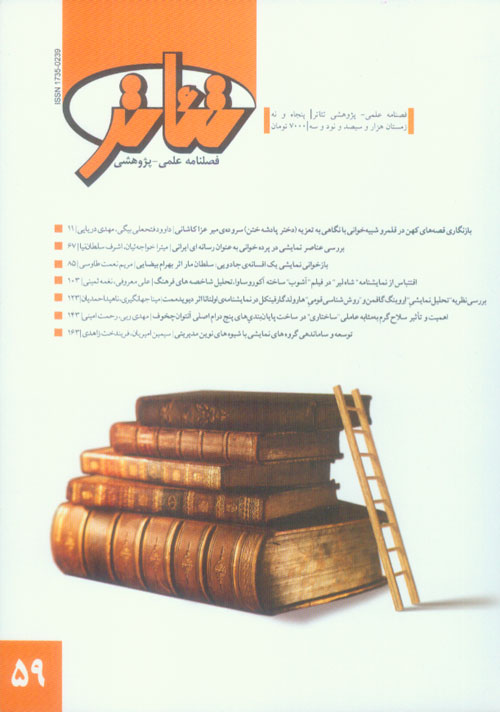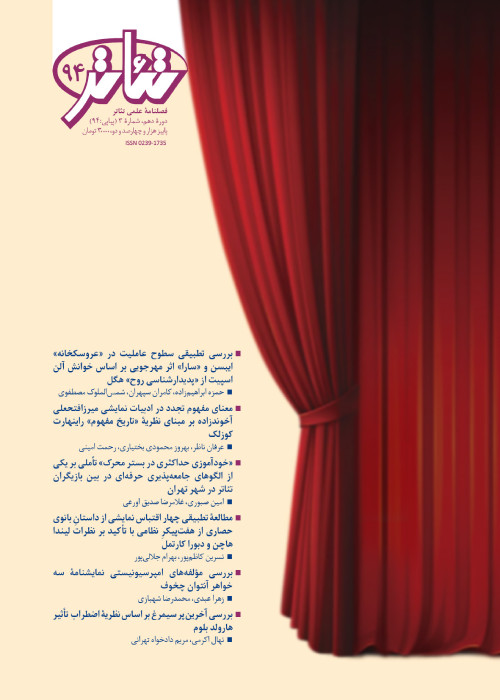فهرست مطالب

نشریه تئاتر
سال یکم شماره 59 (زمستان 1393)
- بهای روی جلد: 70,000ريال
- تاریخ انتشار: 1394/04/24
- تعداد عناوین: 8
-
-
صفحه 7
-
Page 11Joseph and Zoleykha are legendry historical characters who are in world known because of their love and they have been subjected for many writings, poets and stories. The story of Joseph is one of the most popular and interesting stories which is considered a lot by story tellers and Takhteh Howzi performers (comical acts on domestic life). The interest of traditional performers to bring this story on stage was so much that sometimes they made other stories based on it with some changes in its pattern. Daughter of Khotan King is an example of it.Keywords: Shabih, Shabih–Khani, Tazieh
-
Page 67This paper aimed to study Pardeh-khaani (storytelling read off a curtain) as ritual media in Iran's culture which its theoretical framework studied with definition of media, multimedia arts and Pardeh-khaani with its elements and characteristics and findings examined in a way that how religious quotes which are a national media from past to today, affected culture of Iran and still exist in modern art world. This research tried to compare Pardeh-khaani with its traditional features with multimedia art and considering its dramatic aspects resulted that how this alive and dynamic art could develop and according to its Iranian and Islamic look could be introduced to the world. It is worth mentioning that data collection of this research was library method.Keywords: Media, Religious quotes, Iran, Theatre, Pardeh, khaani
-
Page 85From the very beginning of the history of theatre, so many playwrights have adopted myth, tale or a historical narration to create a play. Hardly can one propose a general formulized devise for dramatizing a story. However, it is possible to compare specific element in the story and the plot of the play to embodiment an example of devising a dramatizing a story. The case study of this research is Sultan Mar, a dramatic adoption of a fairy tale. First the plot of the play has been surveyed. It has been enlightened that the dramatist tended to develop a socio-political theme; therefore three sub-plots added till to introduce characters in harmony with play's theme. Then the playwright removed the magical aspects of events and characters to leave the wonder land of the fairy tale and step in real world. Finally he elaborated a complex and spinning plot presenting his key idea strongly.Keywords: dramatizing, fairy tale, de, magic, spinning plot, wearing mask
-
Page 103Lots of new art works are made by adaptating from the old and classic salient works. There are so many art works which has bee reproduced along history over and over again with new arrroaches and views, specially dramas and plays. Plays are capable of being performed for several times with new dramaturgy and different directing. Recently we have faced a new subject, transforming classic dramas to screenplays for television and cinema. In the process of this adaptation (like any other adaptations) an art work which has been created in a special temporal-spatial culture is transferred to another temporal-spatial culture. Doing so, one of the important challenges is to rebuild the created art world of the source work (which is build of cultural material of the source culture) using the cultural material of the destination culture, trying not to decline the artistic and aesthetic effects of the original work. Four cultural parameters: sience, religion, power relationships and gender relationships, are choosen as different aspects of debait in this paper. Other parts of the paper regarding the selected case study (Shakespear’s play: King Lear, Kurusawa’s movie: Ran) have been devoted to the survey of cultural parameters of shakespear’s play and kurusawa’s film. In last part of the paper the selected case study is scrutinized. The findings and the primary results indicate the importance of conformation of cultural parameters in adaptation.Keywords: culture, science, religion, power relationship, gender relationship
-
Page 123Analyzing the social performances in verbal actions and interactions of individuals is one of the recent approaches in the sociological studies (also famously known as micro-level analysis). Such verbal interactions cannot be limited to some manifest features comprehensible by individuals; rather, they include some latent elements which, while may not be directly pointed at in an individual's behavioral actions, certainly play significant role in the analysis of his/her actions. David Mamet, a well-known American playwright, has made his works a playground, the thorough understanding of which is heavily dependent on reconstructing character's action- based performance codified in their silence and speech. These action- based performances are studied in the sociological theories of Erving Gaffman and Harold Garfinkel. The present article attempts to apply these hidden social interactions (namely Gaffman's theatrical performance, impression management, self-representation, before-scene and behind-scene manner, performance evaluation and also Garfinkel's breaching tests in ethnographical methodology) to Oleanna- one of Mamet's best known plays.Keywords: David Mamet, Oleanna, Play, Erving Gaffman, Harold Garfinkel, sociological theories
-
Page 143“Ending,” one of the most important elements of a play, can have an important impact on the minds of the audience. There are some different contributing factors to it such as structural elements, characters, writer’s style and socio-historical milieu of the play. In many of Chekhov’s plays there is a “firearm” which leads to the fateful encounter of “the final interplay” between opposing forces; the firearm which is more than a mere object in the play. It can be a means from pleasure hunting to a means for menace, suicide or personal confrontations. To measure the influence of this firearm in Chekhov’s plays—both as a structural element and a socio-historical factor in Russian life—the composition date of his plays were pondered over in this survey, and it turned out that the influence of this traditional object of Russian life in effectuating the denouement has decreased in his later plays to the extent that two such firearms in his play “The Cherry Orchard,” have become the only firearms in all of Chekhov’s plays that don’t fire.Keywords: Ending, Anton Chekhov, firearm, major plays
-
Page 163In the framework of quality, Changes in the social, moral, economic and cultural development of a society by development indices, is defined. The fundamental indicators of development, the culture and management are important. Considering the relationship between art and literature and the cultural development of each society, can see the influence of cultural elements in the development process. Through these elements and with interaction mechanism of actions and reactions of society, the community's history and heritage are identified. This study attempts to investigate the relationship between the management of performing arts as a cultural media and the matter of development through a detailed analysis of two filed of development and culture with drama. therefore, it attempts to present plainly and briefly the main points of measurement and evaluation of the professional work in the field of performing arts, the quality of the presented works, welcomed the audiences and measured over time, which all can show the process of effectiveness and efficiency of this art and the management that imposed on it. At the same time, to examines the effect of political, social and economic development of these areas in relation dialectical interaction between developer’s uncultured and cultural factors.Keywords: management of performance art, cultural, uncultured elements, planning, performance appraisal, development


